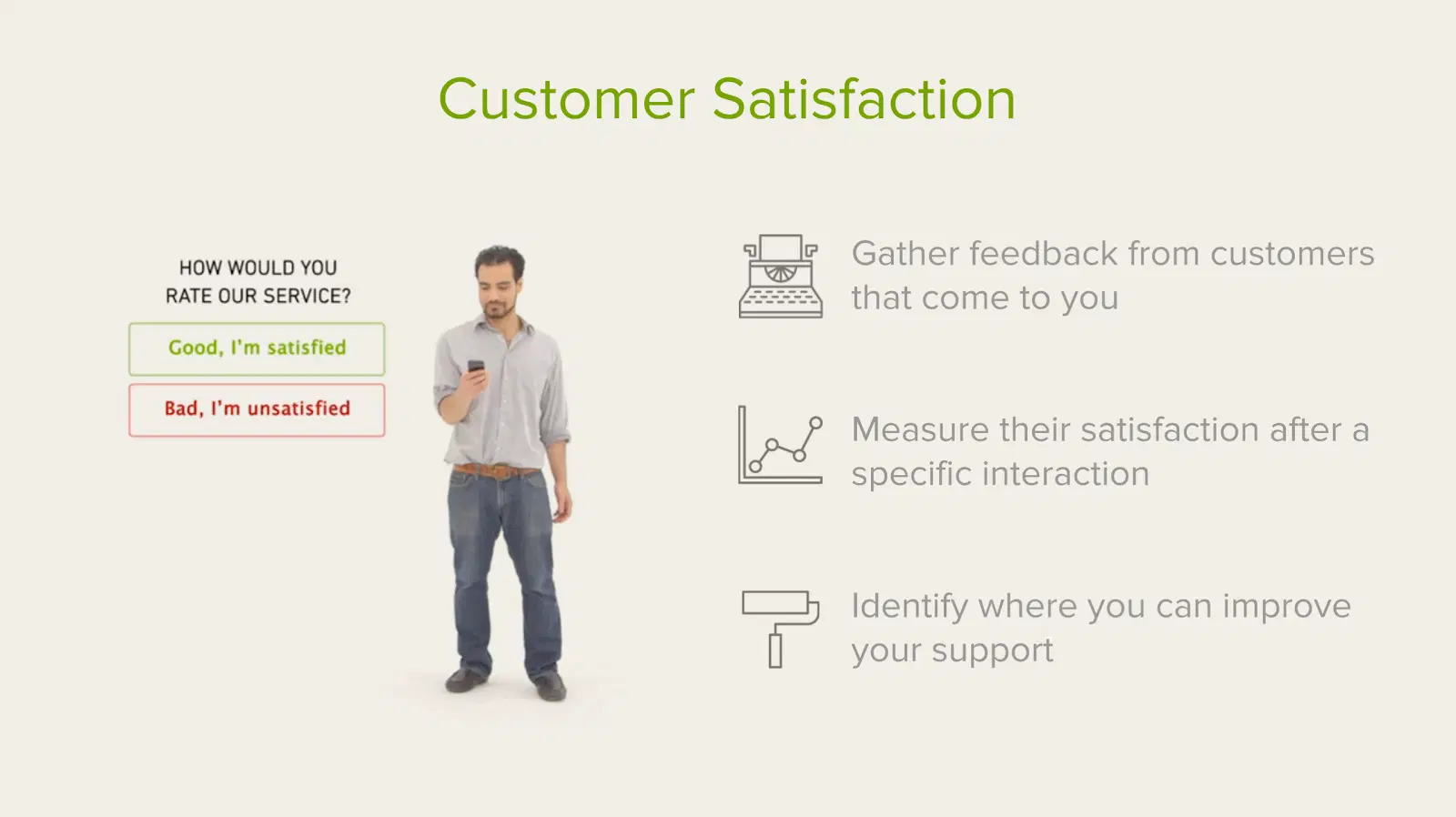CSAT Survey Best Practices

When you develop your CSAT questions, make sure that your question is extremely clear and only related to one experience. CSAT is then calculated by asking customers to rate their satisfaction on a scale.
While companies can choose the way they describe the ratings—even using emojis to represent feelings—and which scale to use, a 1-5 scale is most clear for customers: very unsatisfied, unsatisfied, neutral, satisfied, very satisfied.
Research shows that the top two responses are the best indicators of customer retention. To calculate your CSAT score, add your customers who responded “satisfied” or “very satisfied” and divide them by total responses and multiply times 100. This will give you your CSAT score, represented by percentage.
You can also average your satisfaction scores for a composite CSAT. While easy to calculate and compare within your company, most reported CSAT scores are in percentage form.
Other survey best practices include asking an open-ended feedback question to follow up on why a customer feels satisfied or unsatisfied. Asking for a rating without following up for more information doesn’t get you anywhere.
Make sure to keep surveys short and sweet, as consumers are inundated by survey questions while browsing online, and may be turned off by your survey if it seems to take too long to complete. Customers highly value their time, and your best customer service practice is to save customers time whenever possible.
CSAT Benefits
CSAT is a transactional metric, meaning it is best taken after a completed transaction. This gives you many options, and one of the best things about CSAT is its flexibility. You can ask CSAT questions many times throughout a customer’s journey: after buying a product, calling customer service, or even 6 months after a transaction.
If you have a subscription business model, you can reach out to customers months before the renewal cycle, thus giving you time to fix any issues before customers have to make another purchasing choice.
Another benefit of CSAT is that you get real-time feedback, which helps when you are launching a new product. If you start to see lowered satisfaction, you can quickly make changes and respond to the negative feedback.
You can use also CSAT as a benchmark against your industry by taking a look at the American Customer Satisfaction Index, which has logged CSAT data across industries and companies since 1995.
KPIs for Customer Experience
When using CSAT, be aware of its limitations. Because of its short-term nature, it does not give you a global look at your customers’ feelings toward your company. It also does not measure customer loyalty, only their real-time feelings about an interaction.
A truly healthy customer service plan includes using three key performance indicators (KPIs) to gain a broader perspective of your customers’ overall feelings: Net Promoter Score (NPS), Customer Effort Score (CES), and Customer Satisfaction Score (CSAT).
These three metrics are best used in conjunction with one another, as each have their own pros and cons. They can all be measured through a simple question:
- NPS (customer loyalty): “How likely are you to recommend our product or service to family, friends, or colleagues?”
- CES (customer effort): “How easy was it to deal with our company today?”
- CSAT (customer satisfaction): “How satisfied are you with our company/product/service?”
By looking at NPS, CES, and CSAT, you get a global view of how your company is working, which areas need to be improved, and where you are meeting customers’ needs. These metrics help you focus and become a customer-centric company.
Show Your Customers You Value Them by Using CSAT
CSAT scores help you pinpoint problems with your products and services. To make the best use of CSAT, collect customer feedback to track your negative ratings and what prompted those negative experiences. You can also increase your first call resolution rate by paying attention to how quickly it takes to respond to the issues and how many of those experiences can be resolved, especially with your first interaction.
Sometimes, in all the calculations about our customers, we lose the human touch. Remember that customers want to feel valued and respected. Leveraging CSAT scores provides an excellent opportunity to do that.
Customers enjoy being asked to share opinions and feel like they are part of the process. If a consumer shares feedback, make sure to let them know how you solved the issue. This increases customer engagement, which is linked to customer loyalty.
Some other ways to close the feedback loop include creating customer success blog posts about how you resolved common issues and becoming transparent about your problem-solving process. You can reach out to individual customers who responded negatively, and let them know how their feedback helped, thus improving the overall customer experience.
CSAT is also linked to your employees’ satisfaction and happiness. One study showed that in restaurants who scored higher than average on their customer CSAT, 78% of employees reported that they were satisfied with their jobs. But in the restaurants that were below average in CSAT, only 21% of employees were satisfied. CSAT scores can show the overall emotional health of your company through its customers and employees.
If you want to think creatively, you can come up with many ways to use Zight (formerly CloudApp)’s tools to improve your CSAT score. You can record your screen and create a video, personalize your message with a webcam recording, or reduce resolution time by embedding GIFs into emails. Customers will report higher satisfaction when you save them time, effort, and confusion by using visual communication.
When you look at your CSAT scores, don’t forget the human experience—beyond just dollars and cents. And it will come back to you in spades, through higher customer loyalty, satisfaction, and retention.
How Zight Can Help Improve CSAT
Zight (formerly CloudApp) offers various tools that can significantly enhance your customer satisfaction (CSAT) scores by improving communication and resolving issues more efficiently. Here’s how Zight can help:
- Screen Recording for Clear Explanations:
- Use screen recordings to provide clear and detailed explanations for customer queries. This visual aid helps customers understand complex issues quickly, leading to higher satisfaction.
- Personalized Video Messages:
- Create personalized video responses to customer inquiries using your webcam. Personalized communication can make customers feel valued and understood, enhancing their overall satisfaction.
- GIFs for Quick Solutions:
- Embed GIFs in your emails to demonstrate steps or solutions visually. This can reduce the time customers spend understanding written instructions, making the support process faster and more enjoyable.
- Annotated Screenshots for Precision:
- Use annotated screenshots to highlight specific areas or issues in your communication. This visual clarity can help customers follow along more easily, reducing frustration and increasing satisfaction.
- Real-time Feedback Collection:
- Integrate Zight’s tools to collect real-time feedback after providing support. This immediate feedback can help you identify areas for improvement and address issues before they escalate.
- Efficient Training for Support Teams:
- Train your customer support team using Zight’s screen recording and sharing features. Well-trained staff can handle inquiries more effectively, leading to quicker resolutions and higher CSAT scores.
- Building a Knowledge Base:
- Create a repository of screen recordings, videos, and annotated screenshots to build a comprehensive knowledge base. Customers can access this resource to resolve issues on their own, improving their satisfaction with self-service options.
- Follow-up with Visual Updates:
- After resolving an issue, send follow-up messages with visual explanations of what was done. This transparency can reassure customers that their feedback was acted upon, increasing their trust and satisfaction.
- Highlighting Customer Success Stories:
- Use Zight to create and share customer success stories and resolutions. This not only shows that you value their feedback but also demonstrates your commitment to continuous improvement.
- Reducing Response Time:
- Utilize Zight’s visual tools to reduce the time it takes to respond to and resolve customer issues. Quick and effective responses can significantly boost your CSAT scores.
Learn more about Zight (formerly CloudApp) for Customer Support here.


